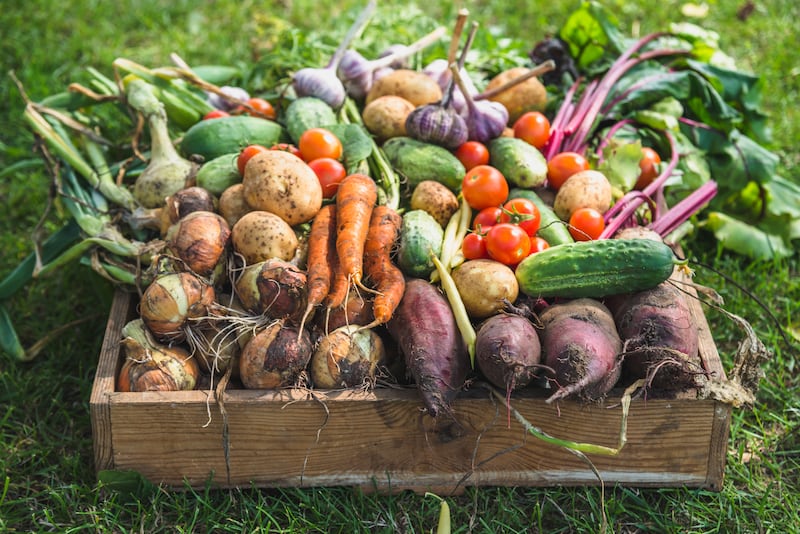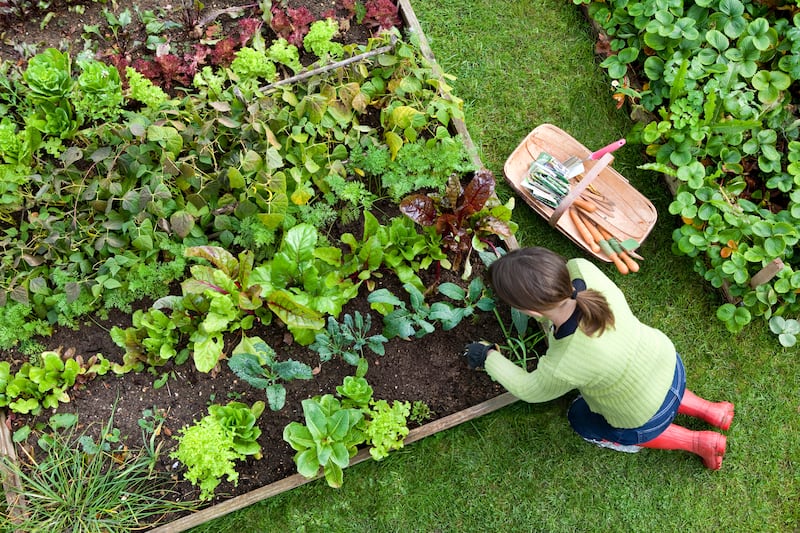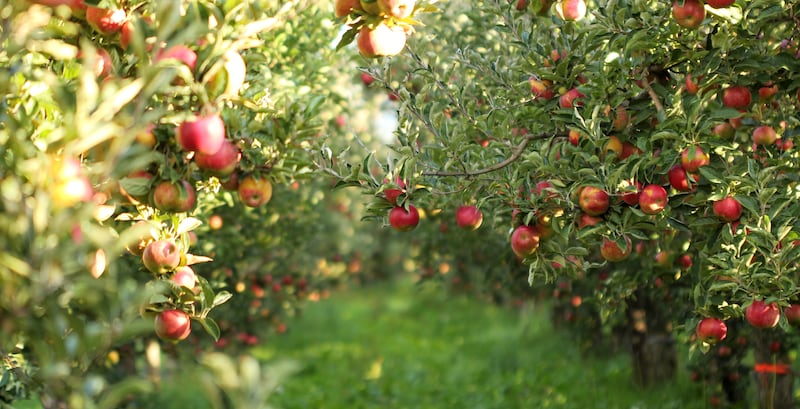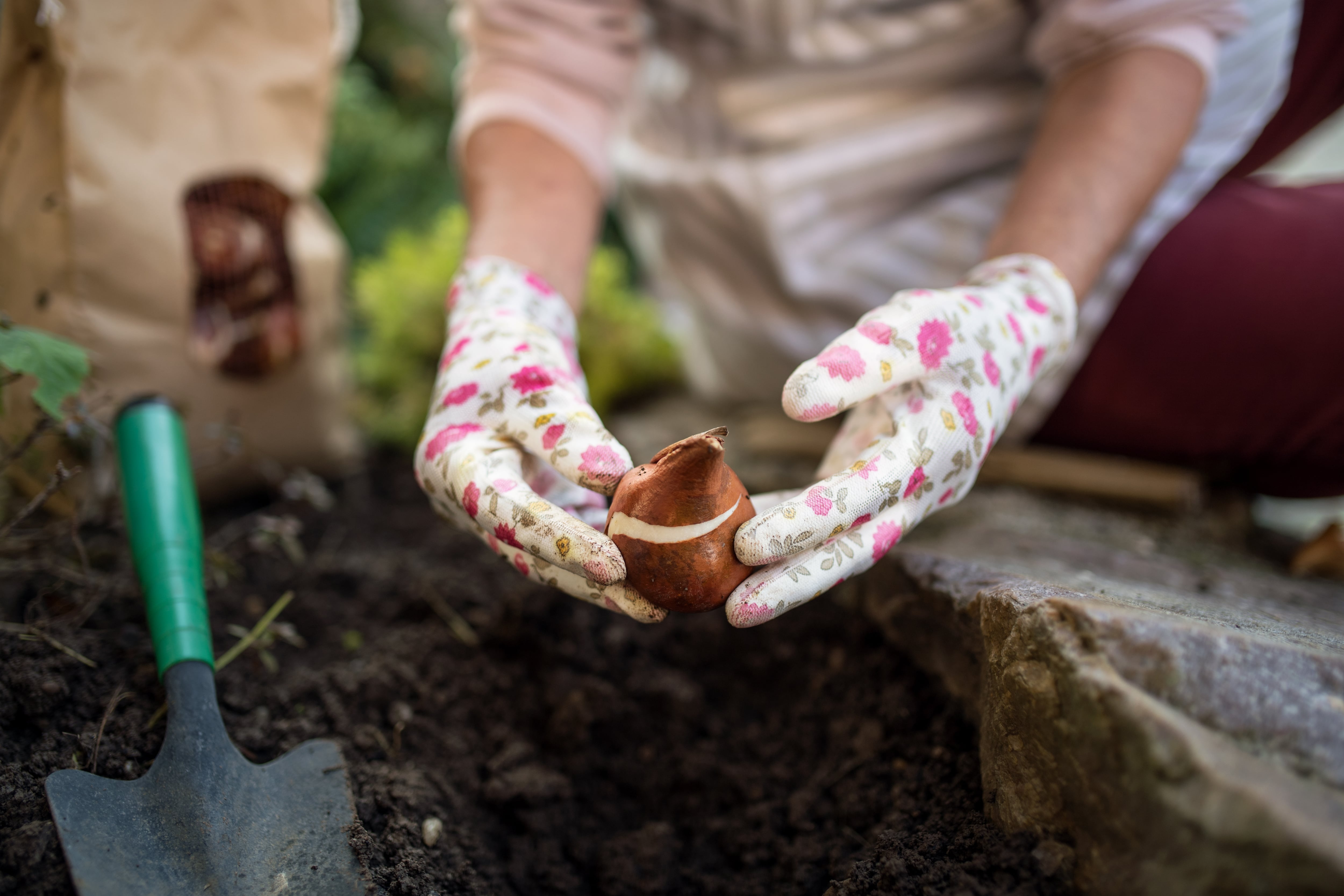I first learned the fundamentals of kitchen gardening from my mother, who learned it from her father, a passing-on of traditional skills repeated down through countless generations.
My grandfather’s small, sheltered, neat-as-a-pin Dublin plot was a place where weed-free rows of carrots and lettuce grew next to carefully-staked sherbet -lemon coloured gladioli, and tidy lines of neatly-trained cordon tomatoes and chrysanthemums filled his home-made glasshouse.
But my mother’s country kitchen garden was a less buttoned-up affair where nature often got the upper hand. Far ahead of the game, her bible was a much-thumbed paperback edition of Rodale’s The Basic Book of Organic Gardening, first published in the very early 1970s. While it didn’t offer much useful advice on surmounting the challenges of growing food on a cold, wet, poor-draining, acid soil in an area of high rainfall and cooler-than-average annual temperatures (the solution, she later discovered, was raised beds), it was ground-breaking in its advocacy of a planet-friendly way of gardening.
More than half a century after it first appeared in print a lot has changed in Ireland in terms of how, why and where the country’s kitchen gardeners grow their own food, much of it for the better. We now, for example, have easy access to a wealth of expert advice in print and online. Thriving organisations such as Community Gardens Ireland, Irish Seed Savers, GIY, the RHSI and the UK’s Garden Organic offer valuable support and resources, while the national allotment movement that first blossomed in the early decades of 20th century has been revitalised. Productive school gardens and community gardens have also taken root around the country, many in cities and towns where demand is so high that it exceeds supply.
READ MORE

Innovative new techniques and modern growing tools and materials have also dramatically transformed the possibilities in terms of what we can successfully grow in our cool, damp, windy little corner of Europe. Just imagine, for example, what the gardeners of 50 years ago would make of our polytunnels and heated propagating mats, or of the wonders of lightweight horticultural fleece, irrigation systems that can be controlled via our mobile phones and apps that can ID a plant pest within seconds.
They’d surely be amazed by a modern global economy that allows us source hand-forged scythes from Switzerland and flower bulbs from the Netherlands at the click of a button. And I can imagine their delight at the many new varieties of fruit, herbs and vegetables bred for their vigour, disease-resistance, productivity and suitability for the Irish climate that are now being grown alongside traditional heritage varieties passed down through the decades.
Underpinning all of these many positive changes is, of course, our dramatically different attitude to food growing. Where once we rolled our eyes we’ve come to appreciate the importance of gardening with respect for the planet. We’ve discovered that home-grown, organically-produced food isn’t just better for us, it’s also better for our world, helping to support biodiversity, sustainability, soil health, food security and community resilience.
Growing even a little of our own food is also hugely empowering, not just for environmental reasons, but also because in a world where so little seems to be under our control it gives us agency. So while it might sound clichéd to say that picking a handful of your own fresh herbs or harvesting a bucket of your very own home-grown potatoes is empowering, for many reasons it’s true. Even at a micro level it fosters mental and physical health and social inclusivity, nurturing intergenerational connections and helping to overcome social and racial prejudices.
With the recent global pandemic, Russia’s war against Ukraine and climate change having together combined to cause a perfect storm in terms of the cost-of-living, it’s also a great way to save money while simultaneously ensuring ready access to some high-quality nutritious food.

The downside to all of the above is that too many of Ireland’s community gardens and allotment sites live a precarious existence, with minimal public funding and no long-term legal protections in place to ensure that they’ll be allowed to continue to operate on their present sites. While many local authorities have been very accommodating and supportive of requests by local communities to use idle land for community gardens and allotments, there’s also no legal obligation for them to do so. The result is that as the demand for land for housing outstrips supply, the opportunities to maintain and create new and much-needed communal growing spaces within our towns and cities are dwindling, even as the average size of an urban garden continues to shrink to the point where finding the space for food growing is a real challenge.
Unlike other parts of the world, most town planners and designers of modern Irish housing developments also continue to take an ultra-conservative approach to the idea of creating shared growing spaces such as community orchards, gardens and allotments within those developments. Meanwhile, waiting lists for allotments in large Irish cities like Dublin are notoriously long and unwieldy, with no guarantee that those on them will eventually get a plot.
The organisation Community Gardens Ireland, which was founded in 2011, has long been campaigning for substantial change in this regard. This week (October 14th-21st) it has launching its inaugural National Allotments & Community Gardens Week: Growing with Nature, a week-long celebration dedicated to recognising the invaluable role that allotments and community gardens play in supporting the health and wellbeing of our communities and the planet. The main event kicks off in Cork city, with tours of Glen Community Garden and Togher Community Garden, but for a full list of events visit cgireland.org.
As for Rodale’s The Basic Book of Organic Gardening, this gardening classic is still going strong, albeit under a slightly modified title. Now called Rodale’s Ultimate Encyclopaedia of Organic Gardening, the Indispensable Green Resource for Every Gardener, you’ll find it for sale on the GIY website (giy.ie).
This week in the garden
Apple trees are now heavy with ripe fruit that should be harvested in the coming weeks before it’s damaged by birds and insects. Just bear in mind that not all varieties are suitable for long storage (later ripening varieties with thicker skin and firmer flesh are best), so some will need to be eaten within weeks of collecting the fruit.

Alternatively, they can be dried in an oven or food dehydrator, or stewed and frozen. Varieties suitable for storage should be placed in shallow, paper-lined boxes in a cool, dry place (an old, disused chest freezer is perfect), making sure to select only unblemished, unbruised fruit to reduce the risk of decay while in storage.
This is the time of year when plants with brilliant autumn foliage colour play such an important role in our gardens. Try to find room in your own to grow at least one and you’ll be entranced by what it brings to the party in terms of seasonal interest. Examples include varieties of euonymus, hammamelis, liquidambar, acer, cercidiphyllum, parrotia and cornus.
Dates for your diary
October 14th-21st, the inaugural National Allotments & Community Gardens Week: Growing with Nature, see cgireland.org
October 25th (7.30pm-9pm) Your Cousin’s a Mushroom, a Zoom talk by Lee Davis, curator of the fungarium at Kew Gardens, on behalf of the RHSI, see rhsi.ie to book tickets
October 29th until November 12th, National Botanic Gardens, Glasnevin, from Crainn na hÉireann, an exhibition of over 60 paintings produced over the last two years by members of the Irish Society of Botanical Artists as a celebration of the seasonal beauty of Ireland’s native trees, see irishbotanicalartists.ie


















